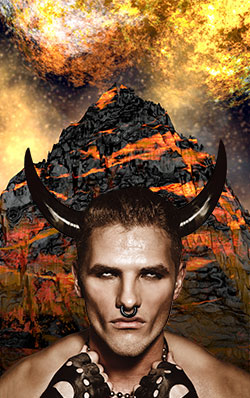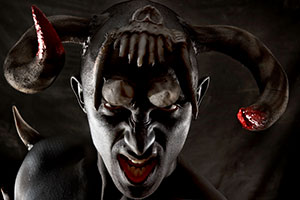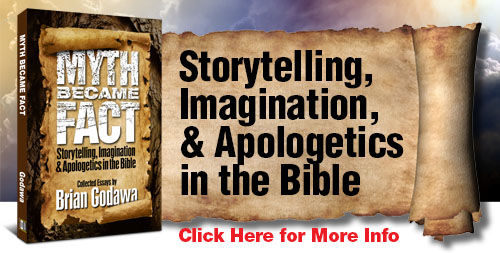The pantheon of gods assembles to battle the chaos monster to protect their territory and kingdom. When the waters of the heavens part, the sea dragon of chaos breaks through and leaves destruction in its wake. The pantheon fights the sea dragon and its monster allies until it is stopped in its tracks by the mighty storm god.
Those who are educated in ancient Near Eastern mythopoeia will recognize this storyline as the Canaanite epic of Baal and Leviathan or the Babylonian epic of Marduk and Tiamat the sea dragon. But what they may not know is that it is also the storyline of the 2012 Marvel blockbuster movie, The Avengers. The purpose of bringing up this point is to call attention to the modern relevancy of this ancient narrative before we descend into the turbulent sea of ancient mythological memes and motifs that are too quickly written off as petty scholarly obsession with obscure archaic minutia that fail to connect to our lives in the modern world. Leviathan vs. the Storm God is still a tale we are retelling today in cultures both religious and secular.
The purpose of this post will be to take a closer look at that ancient Near Eastern narrative of divine combat as it was both appropriated and subverted by the Hebrew authors of the Bible as a polemic for their worldview.
By subversion, we mean the act of transforming an opposing cultural narrative into one’s own narrative with new definitions and new meaning.
With the discovery in the 19th and 20th centuries of religious texts from ancient Near Eastern (ANE) cultures like Babylon, Assyria, and Ugarit, Biblical scholarship has discovered many literary parallels between Scripture and the literature of ancient Israel’s enemies. Like everyone in today’s world, the Hebrews shared many words, images, concepts, and narrative genres in common with their neighbors. And like we do today, those Hebrews incorporated similar literary elements and sometimes changed the meanings within their own worldview context.
With regard to these Biblical and ancient Near Eastern literary parallels, critical scholarship tends to stress the similarities, downplay the differences, and construct a theory of the evolution of Israel’s religion from polytheism to monotheism. In other words, critical scholarship is anthropocentric, or human-centered. Confessing scholarship tends to stress the differences, downplay the similarities, and interpret the evidence as indicative of the radical otherness of Israelite religion. In other words, confessional scholarship is theocentric, or God-centered. In this way, both critical and confessing hermeneutics err on opposite extremes.
In this and subsequent posts, I want to illustrate how the writers of the Old Testament both appropriated and subverted the story, imagery, and metaphor of their religious enemies as a polemic against those enemies’ religion and deities. First, we will look at one of the princes of those pagan deities: Baal.
Baal in Canaan
In 1929, an archeological excavation at a mound in northern Syria called Ras Shamra unearthed the remains of a significant port city called Ugarit, whose developed culture reaches back as far as 3000 BC.[1] Among the important finds were literary tablets that opened the door to a deeper understanding of ancient Near Eastern culture and the Bible. Those tablets included Syro-Canaanite religious texts of pagan deities mentioned in the Old Testament. One of those deities was Baal (alternate spelling of Ba’al).

Baal as he appears in the novel series, Chronicles of the Nephilim.
Though the Semitic noun baal means “lord” or “master,” it was also used as the proper name of the Canaanite storm god.[2] In the Baal narrative cycle from Ugarit, El was the supreme “father of the gods,” who lived on a cosmic mountain. A divine council of gods called “Sons of El” surrounded him, vying for position and power. When Sea is coronated by El and given a palace, Baal rises up and kills Sea, taking Sea’s place as “Most High” over the other gods (excepting El). A temple is built and a feast celebrated. Death then insults Baal, who goes down to the underworld, only to be defeated by Death. But Anat, Baal’s violent sister, seeks Death and cuts him up into pieces and brings Baal’s body back up to earth where he is brought back to life, only to fight Death to a stalemate.[3]
The Dictionary of Deities and Demons in the Bible explains of Baal:
“His elevated position shows itself in his power over clouds, storm and lightning, and manifests itself in his thundering voice. As the god of wind and weather Baal dispenses dew, rain, and snow and the attendant fertility of the soil. Baal’s rule guarantees the annual return of the vegetation; as the god disappears in the underworld and returns in the autumn, so the vegetation dies and resuscitates with him.”[4]
Baal in the Bible
In the Bible, Baal is used both as the name of a specific deity[5] and as a generic term for multiple idols worshipped by apostate Israel.[6] It was also used in conjunction with city names and locations, such as Baal-Hermon and Baal-Zaphon, indicating manifestations of the one deity worshipped in a variety of different Canaanite situations.[7] Simply speaking, in Canaan, Baal was all over the place. He was the chief god of the land.
On entering Canaan, Yahweh gave specific instructions to the Israelites to destroy all of the places where the Canaanites worshipped, along with their altars and images (Deut. 12:1-7). They were to “destroy the names” of the foreign idols and replace them with Yahweh’s name and habitation (vv. 3-4). God warned them, “Take care lest your heart be deceived, and you turn aside and serve other gods and worship them” (Deut. 11:16).
Yet, turning to other gods in worship is exactly what the Israelites did—over and over again. No sooner had the people settled in Canaan than they began to adopt Baal worship into their culture. The book of Judges describes this cycle of idolatry under successive leaders.[8] In the ninth century BC, Elijah fought against rampant Baal worship throughout Israel (1Kings 18). In the eighth century, Hosea decried the adulterous intimacy that both Judah and Israel had with Baal (Hos. 2:13, 16-17), and in the seventh century, Jeremiah battled with an infestation of it in Judah (Jer. 2:23; 32:35).
Baal worship was so cancerous throughout Israel’s history that Yahweh would have to intervene periodically with dramatic displays of authority in order to stem the infection that polluted the congregation of the Lord. Gideon’s miraculous deliverances from the Baal-loving Midianites (Judges 6-8) and Elijah’s encounter with the prophets of Baal (1Kings 18) are just a couple examples of Yahweh’s real-world polemic against Baal. But physical battles and miraculous signs and wonders are not the only way God waged war against Baal in ancient Canaan. He also used story, image, and metaphor. He used literary imagination.

Another incarnation of Baal in Chronicles of the Nephilim.
Yahweh Vs. Baal
Literary subversion was common in the ancient world to affect the overthrow or overshadowing of one deity and worldview with another. For example, the high goddess Inanna, considered Queen of Heaven in ancient Sumeria, was replaced by her Babylonian counterpart, Ishtar. An important Sumerian text, The Descent of Inanna into the Underworld, was rewritten by the Babylonians as the Descent of Ishtar into the Underworld to accommodate their goddess Ishtar.[9] The Babylonian creation epic, Enuma Elish tells the story of the Babylonian deity Marduk and his ascendancy to power in the Mesopotamian pantheon.[10] And then when King Sennacherib of Assyria conquered Babylon around 689 BC, Assyrian scribes rewrote the Enuma Elish and replaced the name of Marduk with Assur, their chief god.[11]
Picture this scenario: The Israelites have left Egypt where Yahweh literally mocked and defeated the gods of Egypt through the ten plagues (Exod. 12:12; Num. 33:4). Pharaoh claimed to be a god, who according to Egyptian texts, was the “possessor of a strong arm” and a “strong hand.”[12] So when Yahweh repeatedly hammers home the message that Israel will be delivered by Yahweh’s “strong arm” and “strong hand,” the polemical irony is not hard to spot. Yahweh used subversive literary imagery, which in effect said, “Pharaoh is not God, I am God.” Nothing like an arm wrestling match to show who is stronger.
But now, God is leading Israel into the Promised Land, which is very different from where they came, with very different gods. “For the land that you are entering to take possession of it is not like the land of Egypt, from which you have come, where you sowed your seed and irrigated it, like a garden of vegetables. But the land that you are going over to possess is a land of hills and valleys, which drinks water by the rain from heaven” (Deut. 11:10-11). And the god of rain from heaven in this new land was believed to be the god of vegetation and storm, Baal.[13]
Now the Biblical text begins to reflect that storm god language in its reference to Israel’s god, Yahweh. Let’s take a look at some Ugaritic texts will give us a literary description of the Baal that Israel faced in Canaan. A side-by-side sampling of those Ugaritic texts with Scripture illustrates a strong reflection of Canaanite echoes in the Biblical storytelling.
UGARITIC TEXTS[14]Baal sits…in the midst of his divine mountain, Saphon, The season of his rains may Baal indeed appoint, the season of his storm-chariot. At his holy voice the earth quaked; now your foe, Baal, |
OLD TESTAMENTYahweh came from Sinai… The voice of the Lord is over the waters; And in His temple everything says, “Glory!”
|
Like the usage of Yahweh’s “strong arm” to poetically argue against the so-called “strong arm” of Pharaoh, Yahweh inspires His authors to use water and storm language to reflect God’s polemic against the so-called storm god, Baal.
Comparing the texts yields identical words, memes, and metaphors that suggest God is engaging in polemics against Baal through scriptural imagery and storytelling. It is not Baal who rides his cloud chariot from his divine mountain Saphon (Sapan), it is Yahweh who rides the clouds as a chariot from mount Sinai. It is not Baal who hurls lightning flashes in wrath; it is Yahweh whose lightning flashes destroy His enemies. It is not Baal whose dew-drenched brow waters the land of Canaan; it is Yahweh who drops dew from heaven to Canaan. It is not Baal’s voice that thunders and conquers the waters resulting in his everlasting temple enthronement; it is Yahweh whose voice thunders and conquers the waters resulting in His everlasting temple enthronement.
Psalm 29 (quoted in part above) is so replete with poetry in common with Canaanite poetry that many ANE scholars have concluded it is a Canaanite hymn to Baal that has been rewritten with the name Baal replaced by the name Yahweh.[16] God was not only physically dispossessing Canaan of its inhabitants; He was literarily dispossessing the Canaanite gods as well. Old Testament appropriation of Canaanite culture is a case of subversion, not syncretism—overthrowing cultural narratives as opposed to blending with them.
Next post, I’ll look at that pesky sea dragon, Leviathan.
[1] Avraham Negev, “Ugarit,” The Archaeological Encyclopedia of the Holy Land, 3rd ed. (New York: Prentice Hall Press, 1996).
[2] Karel van der Toorn, Bob Becking, and Pieter Willem van der Horst, Dictionary of Deities and Demons in the Bible (DDD), 2nd ext. rev. ed. (Grand Rapids: Eerdmans, 1999), 132.
[3] N. Wyatt, Religious Texts from Ugarit, 2nd ed., The Biblical Seminar, vol. 53 (London: Sheffield Academic Press, 2002), 36-39.
[4] “Baal,” DDD, 134.
[5] Judges 6; 1 Kings 18; 2 Kings 10.
[6] Judges 2:13; 1 Samuel 12:10; Jeremiah 2:23.
[7] “Baal,” DDD, 136.
[8] Judges 2:11; 3:7; 8:33.
[9] Stephanie Dalley, trans., Myths from Mesopotamia: Creation, The Flood, Gilgamesh and Others (New York: Oxford University Press, 1989, 2000, 2008), 154-62. The Sumerian version can be found in Jeremy Black, trans., The Literature of Ancient Sumer (New York: Oxford University Press 2004, 2006), 65-76.
[10] Alexander Heidel, trans., The Babylonian Genesis (Chicago: University of Chicago, 1942, 1951, 1963), 14.
[11] C. Jouco Bleeker and Geo Widengren, eds., Historia Religionum I: Religions of the Past (Leiden, Netherlands: E. J. Brill, 1969), 134.
[12] John D. Currid, Ancient Egypt and the Old Testament (Grand Rapids: Baker; 1997), 83.
[13] Fred E. Woods, Water and Storm Polemics against Baalism in the Deuteronomic History, American University Studies, Series VII, Theology and Religion (New York: Peter Lange Publishing, 1994), 32-35.
[14] The abbreviation KTU stands for “Keilalphabetische Texte aus Ugarit”, the standard collection of this material from Ugarit.
[15] All these Ugaritic texts can be found in N. Wyatt, Religious Texts from Ugarit, 2nd ed., The Biblical Seminar, vol. 53 (London: Sheffield Academic Press, 2002).
[16] Aloysius Fitzgerald, “A Note on Psalm 29,” Bulletin of the American Schools of Oriental Research, no. 215 (October 1974), 62. A more conservative interpretation claims a common Semitic poetic discourse.



3 comments on “Of Myth and the Bible – Part 3: Ba’al, the Storm God”
The Ten Plagues Versus the Egyptian Gods The story of the ten plagues that God brought down upon ancient Egypt in Exodus 7 is one of the Old Testament s most famous and dramatic. We normally think of the purpose of these plagues as God’s way of demonstrating his power to the Pharaoh and forcing him to release the Hebrew people from slavery.
As with New Testament believers, Old Testament saints were justified through faith in the God who promised a coming Savior. Kaiser says one of the most beautiful evangelistic stories in Scripture is the Old Testament story of Naaman, in 2 Kings 5.
Comments are closed.